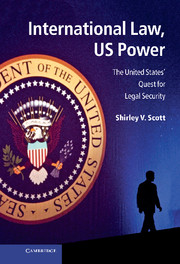Book contents
- Frontmatter
- Contents
- Acknowledgements
- Introduction: beyond the myth of the golden age
- 1 The US quest for legal security
- 2 The US pursuit of legal security through the evolution of the international law of dispute resolution
- 3 The US pursuit of legal security through the evolving regime relating to the use of force
- 4 The US pursuit of legal security in substantive policy arenas
- 5 Techniques through which the United States has reconciled its practice of offensive legal security with the principle of sovereign equality
- 6 The practice of offensive legal security in US diplomacy
- 7 The future of US engagement with international law
- Appendix
- Select bibliography
- Index
- References
3 - The US pursuit of legal security through the evolving regime relating to the use of force
Published online by Cambridge University Press: 05 June 2012
- Frontmatter
- Contents
- Acknowledgements
- Introduction: beyond the myth of the golden age
- 1 The US quest for legal security
- 2 The US pursuit of legal security through the evolution of the international law of dispute resolution
- 3 The US pursuit of legal security through the evolving regime relating to the use of force
- 4 The US pursuit of legal security in substantive policy arenas
- 5 Techniques through which the United States has reconciled its practice of offensive legal security with the principle of sovereign equality
- 6 The practice of offensive legal security in US diplomacy
- 7 The future of US engagement with international law
- Appendix
- Select bibliography
- Index
- References
Summary
‘Without this unqualified right of appeal to arms no nation can be independent’.
Senate Committee on Foreign Relations, Minority Report on the Olney-Pauncefote Treaty, 1897The US quest for legal security, understood as the safeguarding of US law and policies from external influences via international law while using international law to impact on the law and policy choices of other states, has been integral to the US pursuit of traditional, or military, security. The international law addressing the use of force has been a key regime by which to ensure that the US enjoys a structural advantage in the international system. As with participation in the evolving regime of third-party international dispute resolution, US policymakers have shown a high degree of consistency in the nature of their engagement with the evolving regime relating to the use of force. It is worth examining this consistency in some detail because it has been so critical to the achievement of US objectives, and US decision-makers have certainly paid close attention to the detail of the relevant law.
US decision-makers would not ever have considered surrendering decision-making regarding the use of force. It has been deemed vital that the United States retain the freedom to use its military only when it perceived it as in its interests to do so, not assuming any obligation to use force ahead of an actual scenario. For international law to evolve so as to prevent the United States using force should it wish to do so would likewise have been regarded as a severe incursion on US legal security. Once there were restrictions on the use of force in international law, it would also have been unthinkable for the United States to accept a situation in which other states had a legal right to use force against it. This chapter will trace US involvement in the evolution of treaty law related to the use of force, demonstrating the high degree of continuity in positions adopted by the United States and the manner in which those positions have underpinned its legal and military security.
- Type
- Chapter
- Information
- International Law, US PowerThe United States' Quest for Legal Security, pp. 92 - 131Publisher: Cambridge University PressPrint publication year: 2012



